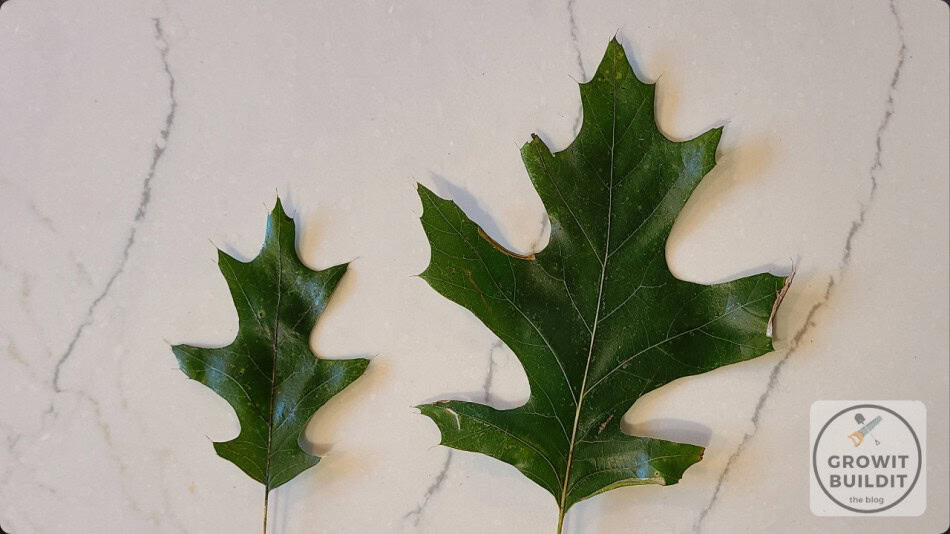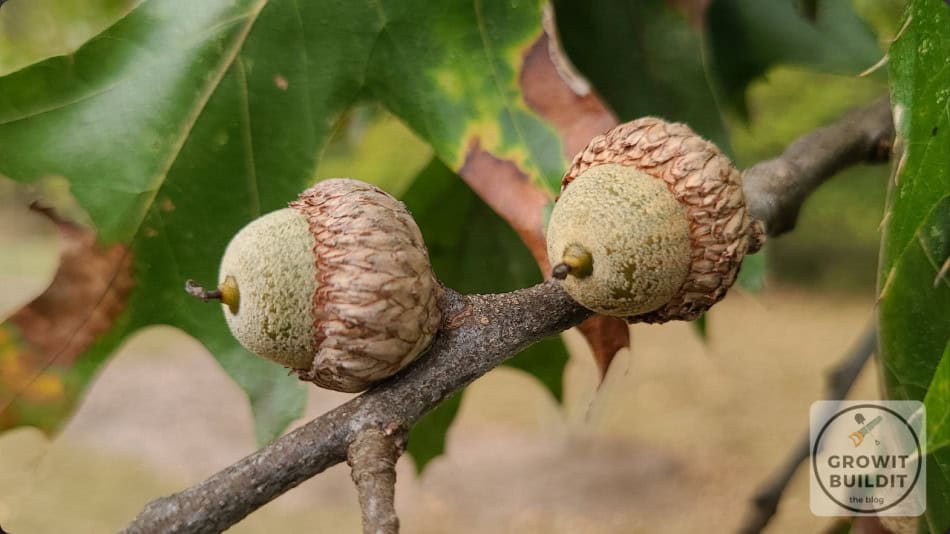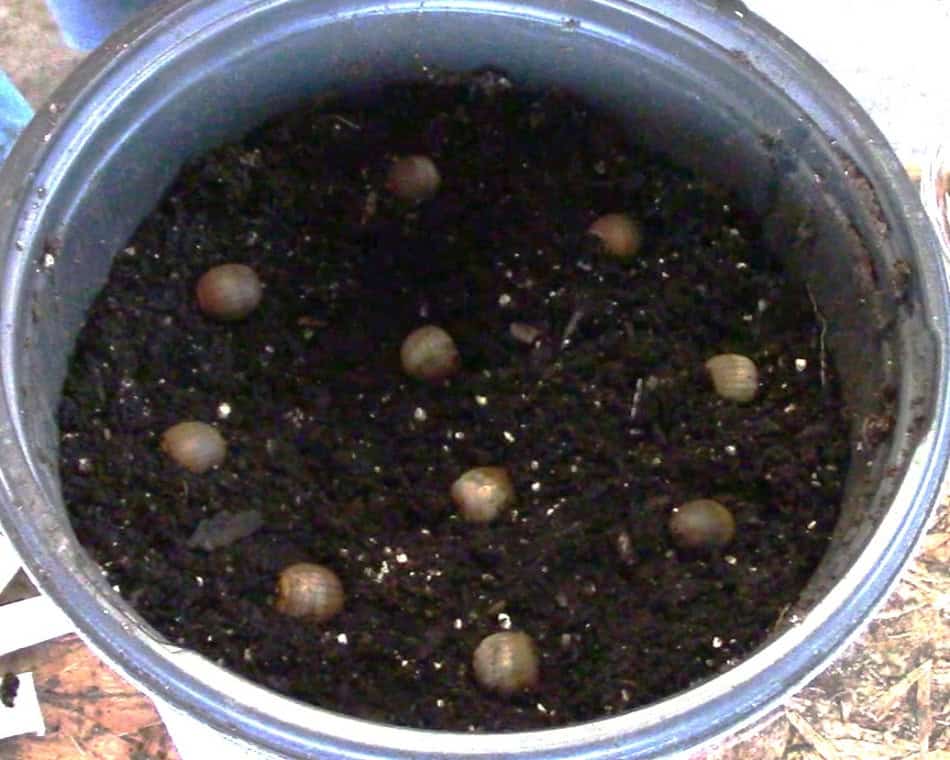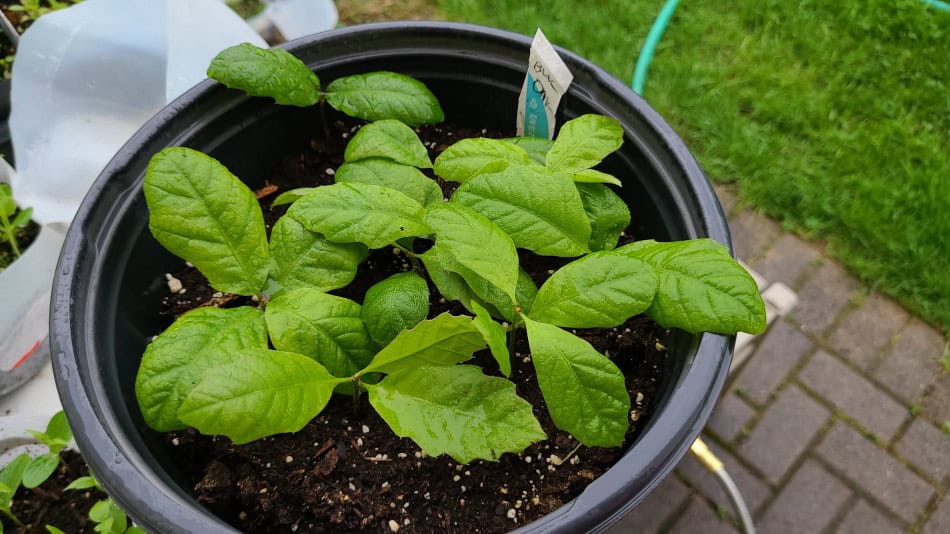Black Oak is a deciduous tree native to Eastern North America and a member of the Red Oak family[1]. Scientifically known as Quercus velutina, it grows upwards of 80′ tall in optimum growing conditions of full sun and well draining soil[2]. An important tree for wildlife, it’s acorns feed numerous mammals and birds while it’s leaves hosts over 50 species of caterpillar[3]. Lumber from Black Oak is highly prized for furniture and cabinet making, where it is sold as ‘red oak’.

The Black Oak cuts a massive shape on the horizon, with wide spreading branches and it’s mature height reaching 60-80′. In perfect conditions, heights of up to 150′ have been recorded[2]. Although not a common landscaping tree, in my area there are several mature specimens that are approximately 50 years old. These massive trees provide copious amounts of shade and often produce a large crop of acorns, which are loved by squirrels and birds. Although these acorns can be annoying to walk on, as they could be a tripping hazard. Still though, the benefits that a Black Oak bring to the ecosystem make this worth it, as you can easily sweep any sidewalk.

But this will be a complete profile on this mighty tree, where at the end you will have a solid grasp on the benefits it can bring, how to identify and grow it, and learn about the ways it benefits the ecosystem and humans alike.
Native Range
The primary native range of Black Oak goes from Louisianna, up to Minnesota and east to Maine/ Florida, including Ontario Canada.

Reference Table
| Scientific Name | Quercus velutina |
| Common Name(s) | Black Oak, Yellow Oak, Smoothbark Oak |
| Native Range, USDA Zone | Eastern North America, USDA Hardiness Zones 3-9 |
| Bloom Time | Spring |
| Bloom Duration, Color | 2-4 weeks, yellow/green |
| Height | 60-80′ |
| Spacing / Spread | 50′ |
| Light Requirements | Full sun to part sun |
| Soil Types | Sandy loam, loam, clay – must drain well |
| Moisture | Dry to medium |
| Fauna Associations / Larval Hosts | Bumblebees, birds / hosts 50+ species of moth |
Benefits
Beauty
Black Oak trees have attractive leaves for most of the growing season. And their shape cuts an impressive site on the horizon, with it’s large round crown.
Fast growing
In forest settings, Black Oak have a slow to moderate growth rate. However, in open settings without competition, they can grow quite quickly at a rate of 2-3′ per year according to the Kansas Forest Service[4].
Shade tree
They make excellent shade trees, as their mature height of 60-80 feet and wide branch structure casts large shadows. They can reach these tall heights relatively quickly provided it has good growing conditions.
Adaptable
Although not shade tolerant, it can handle part-sun, but would prefer full sun. However the only other strict requirement for the tree is that the soil you plant it in can drain well. Other than that though, it can take just about any soil structure.
Wildlife
The value to wildlife is immense, as Black Oak host dozens of species of caterpillar as well as feed numerous other types of insects. These insects, while being important parts of the ecosystem after their larvae stage, will feed numerous species of birds while they are still caterpillars. Then we need to consider the food value of acorns! They directly feed squirrels, rodents, deer, raccoons, and even some birds like Blue Jays.
Identification and Characteristics
Identifying Black Oak can be a bit confusing as it’s cousin Northern Red Oak often grows near it. For a more detailed breakdown on how to differentiate these similar species, see my article with side by side comparison of the leaves, acorns, and bark of these two species.

Related ==> Looking for a smaller Oak that resembles Black Oak? Have a look at Bear Oak. It only grows 25′ tall, and can form a thicket.
Trunk
The crown of Black Oaks, when grown in the open will typically form a somewhat open ovoid or pyramidal crown. The branching is wide spreading and often point up (ascending) on the trunk. Yet when individual branches are examined they are often crooked.
Bark
The bark on the trunk is a black or brown-gray color that is furrowed, but not too deep. This bark will also form irregular-shaped plates, giving a somewhat jigsaw appearance. Branches have smoother bark, and young twigs are brown with white spots (lenticels).

Overall the bark of Black Oak isn’t too unique. What I mean is that it really doesn’t stand out like Northern Red Oak or Chestnut Oak, which are two species that I can identify from a distance from bark alone.
Leaf
Leaves of Black Oak alternately arranged, up to 9″ long by two-thirds as wide, and ovate in shape. They will have 5-9 lobes, and the lobes of Black Oak will almost always extend half-way to the center of the leaf. Often there will also be smaller secondary lobes present. All lobes have a short bristle at the tip.

But just a tip here – do not rely on leaves alone to identify a Black Oak. They are too similar to Red Oak, so much so that they will often confuse plant identification apps.
Flower
Both male and female flowers are produced on the same tree. They are yellow to green catkins that are 4-6″ long, which will hang down from the twigs. Flowers are primarily wind pollinated, although I have found references noting that bumblebees sometimes visit them for pollen.

Acorns
Successfully pollinated flowers will produce acorns that take two whole years to develop. Black Oak acorns are 1/2-3/4″ long, and a distinct characteristic is that their cap will cover half the length of the acorn. This is one of the primary keys to identifying this tree.

Root
The root system of Black Oak is initially a tap-root which will eventually be replaced by wide lateral woody roots.
Growth Rate
The growth rate of Black Oak can range from 1-3′ per year depending on conditions and age. Young trees in the open can grow upwards of 3′ per year, while poorer conditions can yield only 1′ per year.
Age
Black Oak is one of the shorter-lived oaks. In general it doesn’t live longer than 200 years[2].
Growing Conditions
For growing conditions, Black Oak is highly adaptable. It can grow in full sun to part-sun, and in many soil types. It has been noted that it can grow in sandy soils, rocky, and even clay provided it can drain (like on a slope). But you should always test your soil’s drainage before planting a tree.
How to Grow Black Oak from Seed
I have a very detailed article on how to germinate all acorns here, but below I will give you an abridged version.
To germinate Black Oak acorns you will need to subject them to cold-moist stratification of 60-120 days[5]. Since the acorns fall in Autumn, try to collect them when they are naturally dropping from the tree. Remove the cap and inspect the acorn and discard any that have holes. Then perform the float test to make sure they are viable.
You can then either cold stratify in a moist potting mix or sand in the fridge for 2-4 months, or winter sow them. My personal preference is to winter sow the seed, and you can do this by filling a tall (9″) container with moist potting soil and planting the acorn 1-2″ deep, on it’s side. Keep the container in an unheated garage or shed, and add a small amount of water each week to make sure it doesn’t dry out.

As daytime temperatures go above 50-60F, you will have shoots poke out of the soil. Keep them in the shed until some leaves develop, at which point you can move them outdoors – however, you still must be wary of squirrels! At this point you can transplant the tree to it’s final location. I strongly recommend using a 48″ tall tree shelter with stake to protect them, as squirrels will dig up freshly germinated acorns, and deer will also eat the young trees.

If you plant to separate seedlings, take care to keep the newly transplanted seedlings in the shade for several days before slowly reintroducing them to sunlight. To much light right away can induce a heat load on the plant, and the roots will not be attached to the soil so water will not be transported to the leaves. This can be fatal for young seedlings, as it has directly happened to me in the past.
Wildlife, Pests, and Diseases associated with Black Oak
Pollinators
The value of Black Oak to the pollinator community cannot be overstated. This tree hosts 53 species of caterpillar, which in-turn are food for numerous birds.
Other insects
In addition to moth caterpillars, there are other insects like bark beetles, leaf beetles, weevils, treehoppers, leaf hoppers, and others that are too numerous to list here.
Animal threats to Black Oak trees
Deer will eat new growth and are responsible for killing newly germinated trees. Rabbits will also damage young trees in the winter by gnawing on the bark.
Disease
The biggest threat to an Oak tree is Oak Wilt Disease. This is a fungus that is transmitted from insect feet on open wounds of a tree, or from root to root contact with another infected tree. Do not prune your tree when insects are active. If a limb becomes damaged from storms when insects are active, try to cover the wound with breathable shade cloth if possible, as this will act as a barrier to the insects and hopefully prevent infection.
Where you can buy Black Oak
Black Oak isn’t a common tree that is sold, however some larger nurseries may carry it. You can find native plant nurseries near you on our interactive map.
Uses of Black Oak
Landscaping
Black Oak can be used as a shade tree for a home or yard. The roots tend to be a bit shallow though, so it should be planted at least 50′ from the street or driveway. In my own neighborhood, several homes have Black Oak trees, and some of them removed the trees due to roots causing the asphalt driveways to rise.

Lumber
Black Oak lumber is beautiful, and often sold as ‘red oak’. It stains and finishes well, however I would strongly recommend against staining it, as it’s natural color is beautiful by itself.
Medicinal Uses
Several Native American Tribes used Black Oak bark to treat a variety of ailments. The bark was used as an emetic, antiseptic, asthma, was chewed for mouth sores, for treating dysentery, ‘female troubles’, and for treating fevers[6].
Other uses
Acorns were used by the Lakota to make flour, however the tannins needed to be extracted through boiling first. The bark was used to create a red-yellow dye, or blended with other roots to make a brown, black, or gray dye. And the leaves were used for a mattress/bedding[6].
Final Thoughts
Black Oaks are mighty trees that cut an imposing form on the horizon. They are handsome with their dark green foliage, feed all manner of wildlife directly or indirectly, and can also be used to make valuable lumber. These trees don’t get enough attention, and it would be good if more people used them in landscaping.
Find more native plants here
References:
[1] – Quercus velutina, USDA NRCS.
[2] – Sander, Ivan L. “Black Oak.” Silvics of North America 2 (1990).
[3] – Federal Highway Division, Ecoregional Revegetation Application (ERA)
[4] – Black Oak, Kansas Forest Service. Archived version.
[5] – U.S. Dept. of Agriculture. 1948. Quercus velutina, pawpaw, p. 92. In: Woody plant seed manual. U.S. Dept. Agr., Washington, D.C., Misc. Publ. 654. Accessed 17JUL2023.
[6] – Quercus Velutina, North American Ethnobotany Database. Accessed 27NOV2025
Recent Posts
Showy Milkweed is a wildflower native to Western North America. Scientifically known as Asclepias speciosa[1], it typically grows 1-3' tall in full sun and well draining soil[2]. Blooming showy...
Bear Oak is a deciduous short-lived shrub native to Eastern North America[1]. Scientifically known as Quercus ilicifolia, it grows up to 25' tall in full sun and well draining soil[2]. An important...
